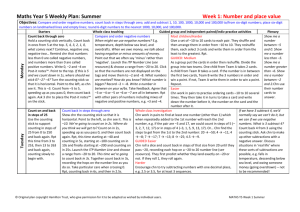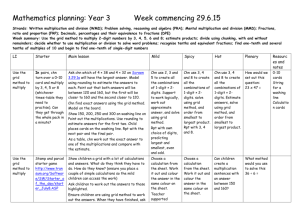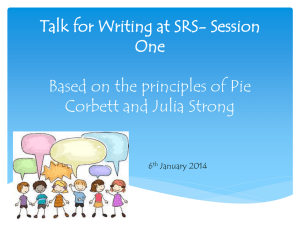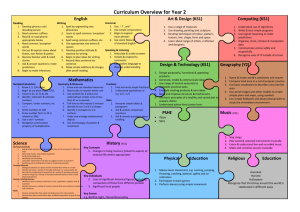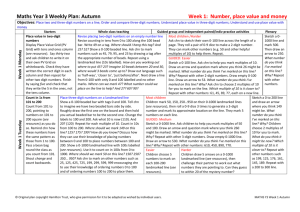Summer Week 1 Plan
advertisement
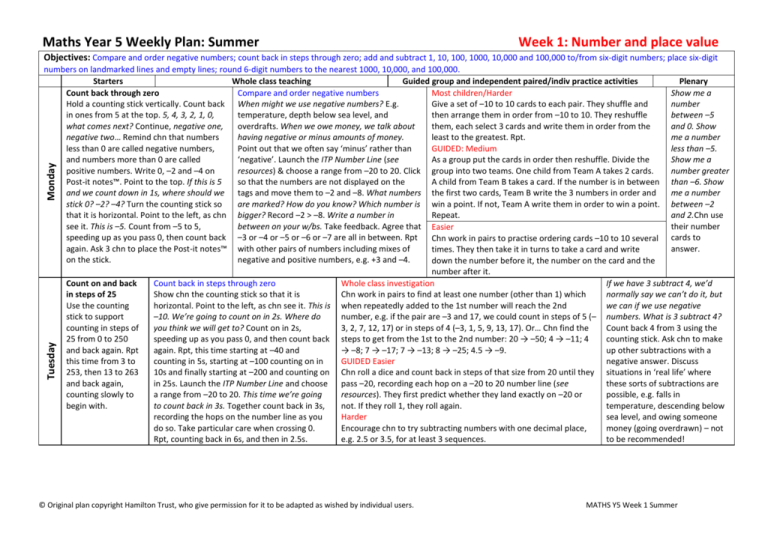
Maths Year 5 Weekly Plan: Summer Week 1: Number and place value Objectives: Compare and order negative numbers; count back in steps through zero; add and subtract 1, 10, 100, 1000, 10,000 and 100,000 to/from six-digit numbers; place six-digit Tuesday Monday numbers on landmarked lines and empty lines; round 6-digit numbers to the nearest 1000, 10,000, and 100,000. Starters Whole class teaching Guided group and independent paired/indiv practice activities Plenary Count back through zero Compare and order negative numbers Most children/Harder Show me a Hold a counting stick vertically. Count back When might we use negative numbers? E.g. Give a set of –10 to 10 cards to each pair. They shuffle and number in ones from 5 at the top. 5, 4, 3, 2, 1, 0, temperature, depth below sea level, and then arrange them in order from –10 to 10. They reshuffle between –5 what comes next? Continue, negative one, overdrafts. When we owe money, we talk about them, each select 3 cards and write them in order from the and 0. Show negative two… Remind chn that numbers having negative or minus amounts of money. least to the greatest. Rpt. me a number less than 0 are called negative numbers, Point out that we often say ‘minus’ rather than GUIDED: Medium less than –5. and numbers more than 0 are called ‘negative’. Launch the ITP Number Line (see As a group put the cards in order then reshuffle. Divide the Show me a positive numbers. Write 0, –2 and –4 on resources) & choose a range from –20 to 20. Click group into two teams. One child from Team A takes 2 cards. number greater Post-it notes™. Point to the top. If this is 5 so that the numbers are not displayed on the A child from Team B takes a card. If the number is in between than –6. Show and we count down in 1s, where should we tags and move them to –2 and –8. What numbers the first two cards, Team B write the 3 numbers in order and me a number stick 0? –2? –4? Turn the counting stick so are marked? How do you know? Which number is win a point. If not, Team A write them in order to win a point. between –2 that it is horizontal. Point to the left, as chn bigger? Record –2 > –8. Write a number in Repeat. and 2.Chn use see it. This is –5. Count from –5 to 5, between on your w/bs. Take feedback. Agree that Easier their number speeding up as you pass 0, then count back –3 or –4 or –5 or –6 or –7 are all in between. Rpt Chn work in pairs to practise ordering cards –10 to 10 several cards to again. Ask 3 chn to place the Post-it notes™ with other pairs of numbers including mixes of answer. times. They then take it in turns to take a card and write on the stick. negative and positive numbers, e.g. +3 and –4. down the number before it, the number on the card and the number after it. Count on and back Count back in steps through zero Whole class investigation If we have 3 subtract 4, we’d in steps of 25 Show chn the counting stick so that it is Chn work in pairs to find at least one number (other than 1) which normally say we can’t do it, but Use the counting horizontal. Point to the left, as chn see it. This is when repeatedly added to the 1st number will reach the 2nd we can if we use negative stick to support –10. We’re going to count on in 2s. Where do number, e.g. if the pair are –3 and 17, we could count in steps of 5 (– numbers. What is 3 subtract 4? counting in steps of you think we will get to? Count on in 2s, 3, 2, 7, 12, 17) or in steps of 4 (–3, 1, 5, 9, 13, 17). Or… Chn find the Count back 4 from 3 using the 25 from 0 to 250 speeding up as you pass 0, and then count back steps to get from the 1st to the 2nd number: 20 → –50; 4 → –11; 4 counting stick. Ask chn to make and back again. Rpt again. Rpt, this time starting at –40 and → –8; 7 → –17; 7 → –13; 8 → –25; 4.5 → –9. up other subtractions with a this time from 3 to counting in 5s, starting at –100 counting on in GUIDED Easier negative answer. Discuss 253, then 13 to 263 10s and finally starting at –200 and counting on Chn roll a dice and count back in steps of that size from 20 until they situations in ‘real life’ where and back again, in 25s. Launch the ITP Number Line and choose pass –20, recording each hop on a –20 to 20 number line (see these sorts of subtractions are counting slowly to a range from –20 to 20. This time we’re going resources). They first predict whether they land exactly on –20 or possible, e.g. falls in begin with. to count back in 3s. Together count back in 3s, not. If they roll 1, they roll again. temperature, descending below recording the hops on the number line as you Harder sea level, and owing someone do so. Take particular care when crossing 0. Encourage chn to try subtracting numbers with one decimal place, money (going overdrawn) – not Rpt, counting back in 6s, and then in 2.5s. e.g. 2.5 or 3.5, for at least 3 sequences. to be recommended! © Original plan copyright Hamilton Trust, who give permission for it to be adapted as wished by individual users. MATHS Y5 Week 1 Summer Thursday Wednesday Maths Year 5 Weekly Plan: Summer Starters Place value in 6-digit numbers Show a vertical place value chart (see resources). Point to 1 number from each column. Ask chn to write, then say the six-digit number created. Include using only 3, 4 or 5 cards, e.g. 340,156; 740,306; and 403,150. Chn write 743,561. Compare pairs of 6digit numbers Chn play in pairs. They each write a 6-digit number, then take it in turns to roll a 0 to 9 dice. If the number rolled is a digit in their number they subtract the number it represents, E.g. they write 572,689 and roll 7, they subtract 70,000. First child to reach zero wins. Week 1: Number and place value Whole class teaching Guided group and independent paired/indiv practice activities Add and subtract 1, 10, 100, 1000, 10,000 Whole class practice and 100,000 to/from six-digit numbers Chn practise adding 1, 10, 100, 1000, 10,000 and 100,000 to/from six-digit numbers Write 457,849 on the board. Chn work in (see resources). pairs. One child writes the number that is Most children: Chn start at question 7 and do as many as they can. 1 less, and the other child write the Easier: Chn start at question 1. number that is 1 more. They show their GUIDED: Harder w/bs. Rpt with 10 more, 10 less, then 100 Display a blank 100-square on the board (see resources) and write 1010 in the top left more/less, 1000 more/less, 10,000 square and 2000 in the bottom right square. Explain that in this square we don't more/less and 100,000 more/less. Rpt count on in ones, but a different but constant step size. Chn discuss in pairs what this with 234, 193 then 352,705. If chn have might be. What would be at the end of the first row? What would you count in to difficulty finding 10 more/less than the move down a column? Agree that we count across in steps of 10, and down in steps of last 2 numbers, ask them to hide the first 100. Rpt for 101,000 in the top left and 200,000 in the bottom right, then 10,000 in 3 digits thinking of 10 more/less than the the top left and 1,000,000 in the bottom right. Challenge them to write one column resulting 3-digit number. for each grid. [Ext: Abacus Textbk 2 p.5 Qs 6-19] Place 6-digit numbers on landmarked lines Most children and empty lines Chn practise placing six-digit numbers on landmarked lines (see resources). Show a 0 to 1,000,000 line marked in [Abacus textbook 2 p.9] multiples of 100,000 (see resources). GUIDED: Medium Choose one of the red numbers to mark Display the 0 to 1,000,000 line used in the main teaching. Split the group into two but not label on the line. Chn write on teams. Team A shuffle a pack of 0–9 cards. They take six and use them in two different their w/bs which number they think you ways to make a pair of 6-digit numbers, then mark them on the line. Team B shuffle the chose, and then explain why. Rpt, asking a cards, take six and use them to try and make a number between those on the line. If so, child to choose a green number and mark the number is marked on the line and Team B wins that round. Otherwise Team A wins. it on the line. The rest of the class to guess Rub out the numbers and rpt. which. Rpt with a different child choosing Easier Harder a blue number, and finally a purple Chn mark Chn play in pairs. They sketch a 0–1,000,000 line across the length number. Ask chn to sketch a line from numbers on of a piece of A3 paper. They shuffle a pack of 0–9 cards. One child 100,000 to 200,000 and to choose one of sections of takes six and uses them in 2 different ways to make a pair of sixthe red numbers. They mark it on their number lines with digit numbers, then marks them on the line. They shuffle the line. They ask a partner to guess which multiples of cards. Child B takes six and uses them to try and make a number they chose. Rpt for each group of 10,000 marked between those on the line. If so, the number is marked on the line numbers. (see resources). and that child wins that round. Otherwise Child A wins. Rpt on a new line. © Original plan copyright Hamilton Trust, who give permission for it to be adapted as wished by individual users. Plenary Write two 6digit numbers with a difference of 1. Write two 6digit numbers with a difference of 10. Now with a difference of 100, now 1000, now 10,000, now 100,000! Mark a number on the 0– 1,000,000 line but do not label it. Each group agree an estimate. Reveal the number. Ask children to say the number 1000 more and 1000 less. Anyone who had an estimate within this range wins a point. Rpt. MATHS Y5 Week 1 Summer Friday Maths Year 5 Weekly Plan: Summer Starters Round 3-digit numbers to the nearest 100 Give a set of 100s cards from a set of place value cards to each table. They choose six to share between them. Use a random number generator such as at http://www.primaryresources.co.uk/ maths/flash/Bingo.swf to generate numbers between 100 and 1000. Chn round to the nearest 100. If they have the answer, they hold it up to score a point for their table. Rpt with a new number. Week 1: Number and place value Whole class teaching Guided group and independent paired/indiv practice activities Plenary Round six-digit numbers to the nearest 1000, 10,000, and Most children/Harder Write three six-digit 100,000 Chn round the population of islands to the numbers on your w/b. Ring Sketch a line on the board from 200,000 to 300,000. A child nearest 100,000, then 10,000, then 1000 a number if it rounds to thinks of a number between the two and marks it on the line (see resources). Suggest they draft 400,000. Ring a number if it but doesn’t write the number. Chn discuss and write an number lines and mark the populations on rounds to 200,000. estimate on their w/bs. They choose two multiples of 10,000 them to help them to round if necessary. Continue until 1 child has for the ends of a new line. Draw this new line underneath [Abacus textbook 1 p.73]] ringed all 3 nos. Write 3 and the child marks the same number on this ‘zoomed-in’ numbers between 700,000 GUIDED: Easier section of the line. Chn revise their estimates, and then agree Sketch a large 0–1,000,000 line with and 800,000. Ring a two multiples of 1000 for new ends of a line. The child marks number if it rounds to multiples of 100,000 labelled. Ask a child the number on, chn revise estimates again. The child reveals 740,000. Ring a number if it to mark on the population of the first the mystery number and labels it on each line. Round the rounds to 780,000. island, and as a group round it to the number to the nearest 100,000, 10,000 then 1000. Rpt with a nearest 100,000. Rpt for each island. Continue until 1 child has new child and a line between 500,000 and 600,000. won. Resources Counting stick Post-it notes™ ITP Number line (see resources) –10 to 10 cards Day 2: Easier –20 to 20 number line (see resources) Day 3: Vertical place value chart (see resources) Day 3: Whole class practice (see resources) Day 3: Blank 100-square to display on the IWB (see resources) Abacus Year 5 Textbook 1 and 2 0–9 dice Day 4: Guess the number sheet to display (see resources) Day 4: Placing numbers on 0–1,000,000 lines activity sheets (versions for Most children and Easier group) (see resources) 0–9 cards Random number generator such as at http://www.primaryresources.co.uk/maths/flash/Bingo.swf 100s cards from a set of place value cards Day 5: Rounding activity sheet (see resources) © Original plan copyright Hamilton Trust, who give permission for it to be adapted as wished by individual users. MATHS Y5 Week 1 Summer Maths Year 5 Weekly Plan: Summer Week 1: Number and place value Outcomes Monday Tuesday 1. Order a group of mixed positive and negative numbers. 1. Count back in steps through zero. Outcomes for most children Wednesday 1. Add and subtract multiples of 1, 10, 100, 1000, 10,000 and 100,000 to/from six-digit numbers. Thursday Friday 1. Place six-digit numbers on landmarked lines and empty lines. 1. Round 6-digit numbers to the nearest 1000, 10,000, and 100,000. Default (outcomes for children not on statements but not able to reach the outcomes for most children) 1. Order a set of consecutive positive and negative numbers. 1. Count back in steps through zero. 1. Add and subtract 1, 10, 100, 1000, 10,000 and 100,000 to/from six-digit numbers. 1. Place six-digit numbers on landmarked lines. 1. Round 6-digit numbers to the nearest 100,000. Only record names of children who struggled or exceeded these outcomes Scroll down for information about web links The links to the websites and the contents of the web pages associated with such links specified on this list (hereafter collectively referred to as the ‘Links’) have been checked by Hamilton Trust (being the operating name of the registered charity, William Rowan Hamilton Trust) and to the best of Hamilton Trust’s knowledge, are correct and accurate at the time of publication. Notwithstanding the foregoing or any other terms and conditions on the Hamilton Trust website, you acknowledge that Hamilton Trust has no control over such Links and indeed, the owners of such Links may have removed such Links, changed such Links and/or contents associated with such Links. Therefore, it is your sole responsibility to verify any of the Links which you wish you use. Hamilton Trust excludes all responsibility and liability for any loss or damage arising from the use of any Links. © Original plan copyright Hamilton Trust, who give permission for it to be adapted as wished by individual users. MATHS Y5 Week 1 Summer

